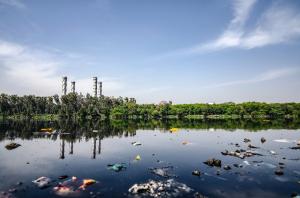Microvi Announces Unprecedented Results for its Chromium Removal Technology
Published on by Water Network Research, Official research team of The Water Network in Technology
 Microvi MNE successfully removes chromium from contaminated water.
Microvi MNE successfully removes chromium from contaminated water.
The results of work completed demonstrated a combination of efficacy and cost reduction that has not been demonstrated with any technology on the market today.
Microvi announced today the successful application of their MicroNiche Engineering (MNE) platform technology for chromium removal. The work, conducted under a National Institute of Health grant, demonstrated a significant potential cost savings in capital, operations and maintenance costs compared to conventional treatment technologies such as ion exchange and reduction-coagulation-filtration. The combination of efficacy and cost reduction has not been demonstrated with any technology on the market today.
“Applying our expertise in water purification solutions to address the worldwide challenge of chromium contamination demonstrates the versatility of our MNE platform technology,” said Ameen Razavi, Chief Innovation Officer of Microvi. “This work allowed us to continue to push down treatment costs while maintaining exceptional treatment performance.”
Chromium in water stems from both natural sources as well as a variety of industrial activities including paints, metal production and manufacturing processes. Its presence has significant impacts on public health as it is a carcinogen and can lead to reproductive harm. The widespread issue of chromium contamination affects millions of people worldwide. In a study conducted by the Environmental Working Group, 218 million Americans throughout all 50 states were found to drink chromium-polluted tap water.
While the current federal standard for total chromium in drinking water is 100 parts per billion (ppb), this regulation is under review. Some areas, like California, a region particularly impacted by naturally occurring chromium, have proposed limits as low as 10 ppb. This study showed that Microvi MNE successfully removes hexavalent chromium from drinking water to levels of 5 ppb, meeting both current and potential future regulatory limits.
By using novel biocatalytic composites (MNE biocatalysts) to intensify and extend the life of biological processes, the Microvi MNE technology maintains a controlled population of microorganisms at a much higher density than existing technologies. The design and operation of the systems are simple with no complex process controls and do not produce additional solids, reducing energy and carbon requirements.
Microvi’s water technologies have been successfully applied in a number of applications across the water, wastewater and bio-based chemicals sectors. Along with a project focused on tertiary ammonia removal completed at Thames Water in the UK, the technology was selected for the first full scale wastewater sidestream treatment project in the San Francisco Bay, and for nitrate removal from drinking water at Cucamonga Valley Water District.
Taxonomy
- Heavy Metal Removal
- Heavy metals
3 Comments
-
We offer a range of solutions to monitor metal in water at low concentration (1 ppb) using a fully automatic analyser.
Contact us at jean-philippe.pavard@klearia.com and visit our website: www.klearia.com.
-
The method is good and interesting. Technology leads us to better remove impurities and purify water.
-
Wastewater from electroplating facilities, chemical, petrochemical, and other industries may contain chromium, nickel, zinc, lead, iron, copper, manganese, and other heavy metals. Several methods and technological flow diagrams have been developed with the use of AVS Vortex Layer Device to treat wastewater, which allows to reduce significantly the consumption of reagents, to achieve more complete treatment, and to transfer it to a continuous mode.
The reduction of hexavalent to trivalent chromium is carried out in an alkaline medium using iron sulfate and the simultaneous precipitation of heavy metals in the form of hydroxides. This method is implemented in wastewater, which has 10–200 mg / l Сr + 6 at the acidity of wastewater from pH = 6 to several grams and the presence of other heavy metals from 10 to 1,000 mg / l
Wastewater treatment by reduction of Cr6 in an alkaline environment with simultaneous precipitation of heavy metals in the AVS type BA-100 (ferromagnetic elements: mm; g; before treatment - pH 2 ... 3, after treatment - pH 8.5 ... 9)
The experiment of the AVS implementation has shown that it is the most appropriate to use the reduction method of Cr + 6 to Cr + 3 in an alkaline medium with an amount of chromium in solution max. 200 mg / l.Recovery of Cr + 6 to Cr + 3 with sodium bisulfite in acidic medium, followed by the precipitation of Cr + 3 in an alkaline medium using the AVS in both the first and second stages can be recommended with a significant amount of chromium.
Intensification and completeness of acid-base wastewater treatment from heavy metal ions using the AVS takes place due to complex treatment of components in the vortex layer due to the formation of metal hydroxides, their precipitation and sorption of heavy metal ions by iron hydroxide, as well as an activated colloid, which is formed due to the dispersion of ferromagnetic elements in the vortex layer and is a good reducing agent.
The most effective purification process occurs while implementing a suspension of lime as a reagent, which is activated during processing in the AVS. The activation is confirmed by the IR spectra of CaO of lime milk after treatment in a vortex layer, which indicates structural and physical changes in the properties of CaO. It allows achieving the degree of purification to the GDK standart at a CaO consumption of up to 90-100% of the theoretically required.
For more information about equipment (AVS) please contact me anytime
Best regards:
Stanislav Kopytko
e-mail: kopytko.s.globecore@gmail.com
phone: +38 095 478 2422 WhatsApp, Viber, Messenger+4 942 136 583 213